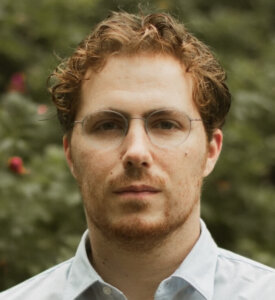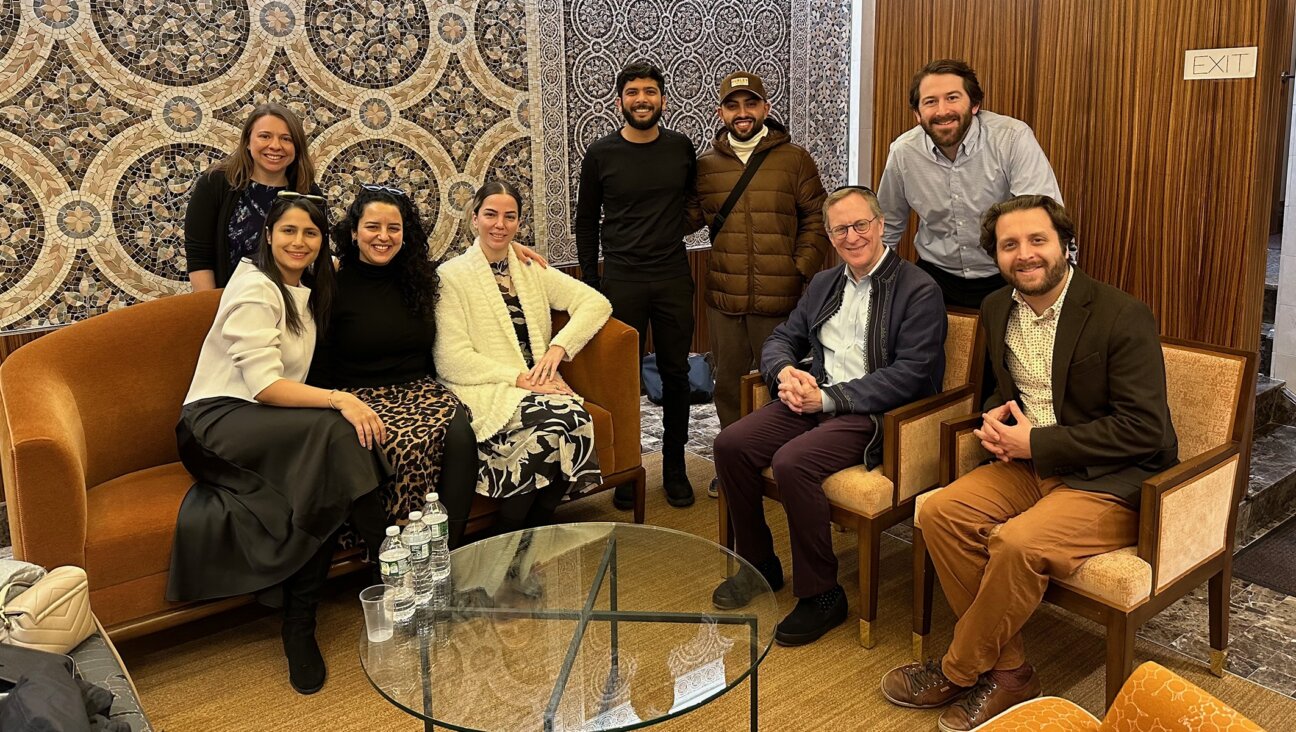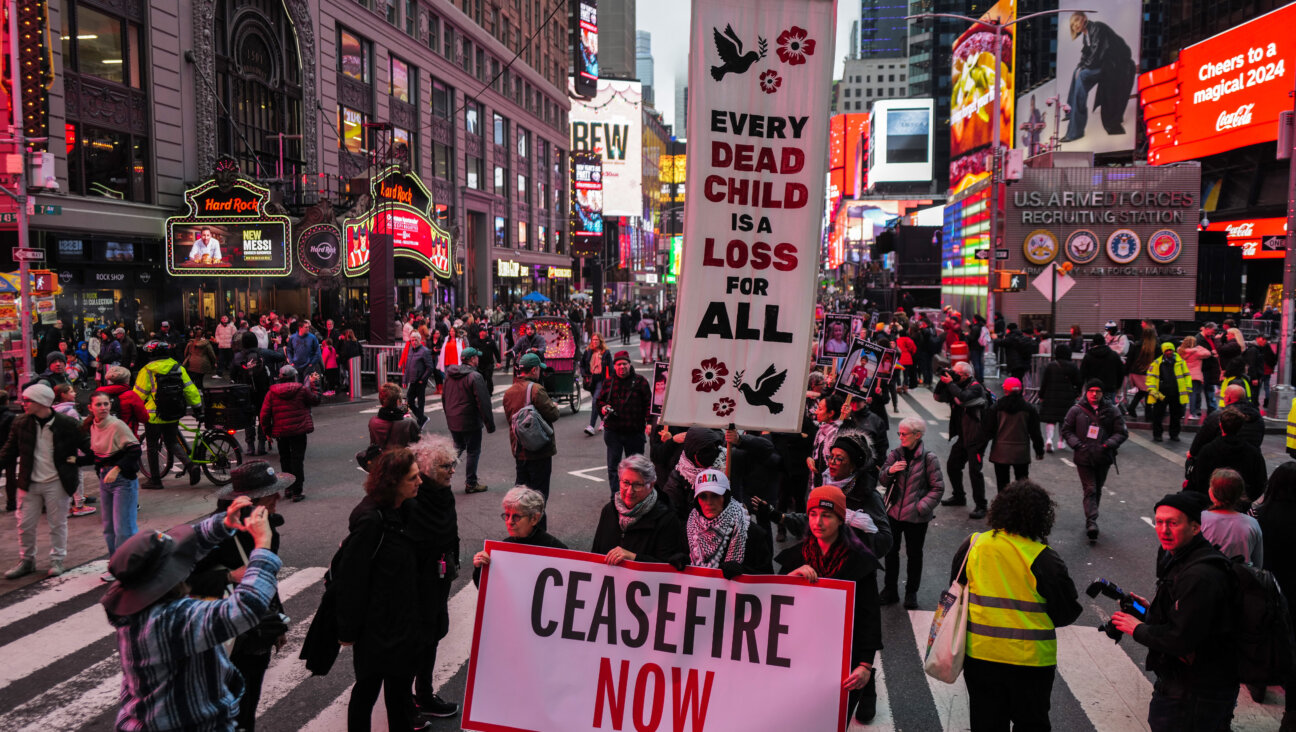Eulogized for championing women, Reform leader now accused of abusing them

Graphic by Angelie Zaslavsky
In the summer of 1992, Rabbi Alfred Gottschalk ordained Israel’s first female rabbi. The head of the Reform movement’s seminary, 62-year-old Gottschalk called Naamah Kelman’s ascension to the role “of great historic and symbolic importance.”
“It reaffirms what we know to be true in Judaism,” Gottschalk, leader of Hebrew Union College-Jewish Institute of Religion, told the Jerusalem Post at the time. “In our faith there is an inherent egalitarian principle which sees men and women as equal partners in the service of God.”
The sentiment was in keeping with Gottschalk’s public persona. He had ordained the first female rabbi in North America, Sally Preisand, 20 years earlier, and was the first president of the seminary to admit openly gay and lesbian students.

Alfred Gottschalk, president of HUC-JIR, at the ordination of Naamah Kelman, the first woman to be ordained in Israel, 1992. Courtesy of Jewish Women's Archive
But at the same time that Gottschalk was voicing the importance of gender equality in the press, he was allegedly harassing female students and staff at the college’s Jerusalem campus and assaulting them at his apartment in the city. A new report on the seminary, as well as interviews with those who knew Gottschalk and spent time on HUC campuses when he led the seminary, describe a man whose behavior toward women clashes with his public legacy.
“A very consistent pattern of alleged misconduct occurred,” according to an independent investigation commissioned by and released by HUC-JIR Tuesday. “Dr. Gottschalk allegedly invited women to his apartment or hotel room, usually under the guise of some academic purpose, only to proposition the student and touch or kiss them.”
Pamela Nadell, a historian of Jewish women, met with Gottschalk during her research for “Women Who Would Be Rabbis: A History of Women’s Ordination,” and called the report a revelation.
“It’s a stunning document,” said Nadell.
The allegations
The report describes harassment at HUC from the 1970s to the present and identified six men on the faculty whose behavior was particularly egregious, including two of the seminary’s past presidents: Gottschalk and Sheldon Zimmerman. Zimmerman and sociologist Steven Cohen are the only two of the six who are still alive. Both resigned from their roles in 2000 and 2018, respectively. Zimmerman did not respond to a request for comment Tuesday. Cohen has not disputed past allegations and previously apologized for “inappropriate behavior.”
The investigation is part of a broader societal reckoning over sexual misconduct that began four years ago with the #MeToo movement. In addition to the seminary, the Reform movement’s other key institutions — the Central Conference of American Rabbis and the Union for Reform Judaism — are conducting similar investigations.
Most of the incidents involving Gottschalk outlined in the 37-page report took place in Jerusalem, where Gottschalk worked for decades to expand the Reform movement’s presence in Israel. The earliest alleged assault by Gottschalk occurred in the mid-1970s, when he called a female student to his apartment and placed her hand on his penis.
“Look what you do to me,” he reportedly told the woman.
The report also describes an alleged incident in the late 1980s when Gottschalk asked a college staff member to stay behind after a gathering at his apartment and then allegedly pushed her against a wall, grabbed her arm when she tried to escape and then attempted to put his tongue in her mouth. Gottschalk made repeated contact with both women, they told investigators, requesting that they return to his apartment and in one case sending flowers.
“You can help me feel better and make me less lonely,” Gottschalk reportedly told a third woman who he invited to his apartment several times throughout her time studying in Jerusalem. The woman said that he put his hands on her knees, shoulder and once wrapped his arms around her.
Attorneys for Morgan Lewis, the law firm that conducted the investigation, wrote in their report that Gottschalk “had a well-known reputation as a womanizer” and that several faculty members were aware of his behavior.
“It has been a widely known, open secret for decades,” said Mary Zamore, a Reform rabbi and director of the Women’s Rabbinic Network. “I would not say that everybody knew but it was an open secret.”
An unearned legacy?
Yet Gottschalk, who died in 2009, has been memorialized as a champion of women’s rights. David Ellenson, president of the college at the time of Gottschalk’s death, eulogized him as “an advocate for women’s rights in Judaism” whose contributions to Reform Judaism “will endure as a sacred legacy and a source of inspiration.” Contemporaneous obituaries likewise led with Gottschalk’s role in ordaining women and welcoming LGBTQ students into the seminary.
Ellenson did not respond to a request for comment.
The report stated that Gottschalk was once told to stay away from a particular female student, which he apparently did. But investigators found no indication of any complaints or discipline in his personnel files. And his behavior remained hidden from public view until Zamore delivered a speech to a conference of Reform rabbis last spring where she described hearing stories of Gottschalk’s harassment and of women warning each other to stay away from him.
“At my ordination, it felt like a travesty to have Rabbi Gottschalk’s hands lay on my head to ordain me,” Zamore told the audience.
While Hebrew Union College has declined to comment specifically on the allegations against Gottschalk, and has instructed current faculty to refer press inquiries to the school, he retains some defenders.
Naomi Gryn, whose father Hugo Gyrn was a prominent British rabbi and friends with Gottschalk, said that he should be credited with liberalizing Judaism in significant ways.
“The reform rabbinate of Freddie’s and my father’s era helped break barrier after barrier, from patrilineal descent to same-sex marriage,” Gryn said in an email, using a nickname for Gottschalk. “It was a far cry from, say, the misogyny and homophobia still inherent in the Orthodox world.”
Gottschalk ordained 242 female rabbis, according to the Central Conference of American Rabbis, and it appears that Zamore was not alone in feeling violated by his role in their ordination. Laura Geller, the third woman to be ordained by the Reform movement, recalled telling Gottschalk that he should not try to hug or kiss her during the 1976 ceremony.

Rabbi Laura Geller was ordained in 1976 as the third woman to become a Reform rabbi.
Geller, who went on to lead Temple Emanuel of Beverly Hills, recalled a difficult environment for women at the seminary in the 1970s and said Gottschalk was widely known to be involved in “inappropriate relationships” with students, including at least one that appeared consensual at the time but which Geller said could not have been given the power dynamic.
“I never knew him to be a feminist in any way,” Geller said. “He was a creepy guy.”
(Geller spoke to investigators for the report about harassment she suffered from Stephen Passamaneck, a professor of rabbinic literature, now deceased, whose attempt to humiliate her she said nearly drove her to quit the program.)
Much of Gottschalk’s credibility when it came to advancing women’s rights stemmed from his ordination of Priesand — over the objection of several faculty members — the year after he became president. But Priesand, who did not respond to a request for comment, credited Gottschalk’s predecessor, Nelson Glueck, with enabling her to become a rabbi.
The National Federation of Temple Sisterhoods had been lobbying for decades to allow women to be ordained, a move that the Reform movement agreed to in principle in the early twentieth century but did not act on for decades. In the early 1960s, the women’s group announced that it was planning to make a formal push to open the rabbinate and began an education drive powered by sisterhoods across the country.
“You had hundreds of these women’s groups that were putting this on their agenda and talking about it,” said Marla Feldman, the director of Women of Reform Judaism. “It was classic organizing that led up to this.”
In that sense, Gottschalk’s role in opening the ranks of Reform clergy may have been a matter of being president at a time when these changes were already afoot, rather than an expression of strong personal conviction.
A problem bigger than Gottschalk
Many also say that the broader climate of hostility toward women and minorities at the seminary detailed in the investigation was likewise not solely the fault of Gottschalk.
“What was happening at HUC was just a microcosm of what was going on in the wider world,” said Nadell, a professor at American University.
Female students, staff and faculty being held to double standards and facing various forms of harassment was something experienced by women entering many professional fields during the 1970s and 1980s that had previously been closed to them.
“HUC was not in any way unique and I would think better than most despite the fact that definitely there is some accounting to be done,” said Feldman, who attended the school and was ordained by the college in 1985.
Still, a survey conducted by the Women’s Rabbinic Network in 1980 of Reform congregations found a litany of fears about hiring female rabbis, including that the Torah was too heavy for them to carry, that they would cry too much, would quit after getting pregnant or were too “faddy.”
That last allegation may have been embraced by Gottschalk himself. While it does not name him, the investigation stated that the school’s president in the early 1970s, when Gottschalk was in charge, “opined that women in the rabbinate was a passing fad.”
The team of Morgan Lewis attorneys, led by Grace Speights, recommended a series of steps the college should take.
These include creating a forum for survivors to share their experiences; offering a “reordination” ceremony for those ordained by known harassers; removing endowed chairs, statutes and other public memorials to “wrongdoers” — one former student said she felt the urge to spit on a bust of Gottschalk located on campus — appointing an ombuds; standardizing the policies on consensual relationships and posthumously ordaining Helen Leventhal Lyons, who was the first woman to complete the full course of study at the Jewish Institute of Religion in 1939 but was not allowed to become a rabbi.
The college’s board is meeting in December to consider how it should respond to the report.
Elana Wien, who leads the SRE Network, cautioned the broader Jewish community against focusing too much on the Reform movement. Instead, Wien said, other Jewish institutions should take the report as a prompt to examine their own problems.
“There’s a real danger in and tendency to want to exceptionalize this and really attribute it to a particular institution or a particular set of ‘bad actors,’” Wien said. “But the real work is understanding that we have these issues everywhere.”
Correction: The original version of this article misstated the year that Helen Leventhal Lyons completed her course of study. It was 1939, not 1923.

















